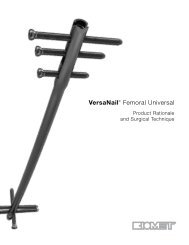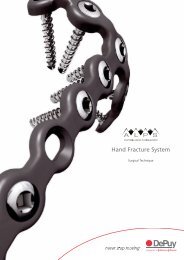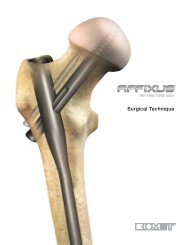VERSANAIL Tibial Nailing System Surgical Technique - Biomet
VERSANAIL Tibial Nailing System Surgical Technique - Biomet
VERSANAIL Tibial Nailing System Surgical Technique - Biomet
You also want an ePaper? Increase the reach of your titles
YUMPU automatically turns print PDFs into web optimized ePapers that Google loves.
Read the measurement<br />
from the etch mark<br />
on the guide wire.<br />
Fig. 10<br />
Nail Diameter Selection<br />
Nail Size Selection<br />
An X-ray template is available to determine nail size<br />
preoperatively (Cat. No. 2810-12-020) (Fig. 10).<br />
Generally, a nail diameter 1 mm less than the final reamer diameter is chosen. For<br />
nail sizes 8-11 mm, the proximal diameter is 11.5 mm. For nail sizes 12 and 13 mm,<br />
the proximal nail diameter matches the shaft diameter.<br />
When treating distal tibia fractures with a tibial nail, stresses are increased on the<br />
nail’s distal portion. For distal tibia fractures, it is recommended that the surgeon<br />
use the largest nail diameter that will fit into the medullary canal, without excessive<br />
thinning of the cortex.<br />
Fig. 11<br />
Nail Length Selection<br />
Slide or snap the nail length gauge (Cat. No. 2810-01-009)<br />
onto the ball nose guide wire until it contacts the bone. Read<br />
the measurement that lines up with the etch mark on the<br />
guide wire to determine the nail length (Fig. 11). A direct<br />
measurement can also be taken of the uninjured extremity<br />
using either radiographs with magnification markers, or<br />
directly on the uninjured limb from the flare of the medial<br />
malleolus to the tibial tuberosity’s proximal aspect.<br />
5

















